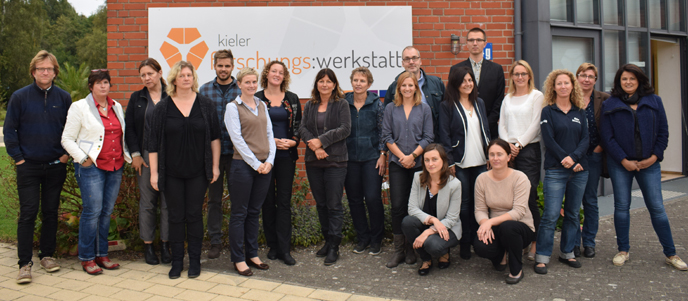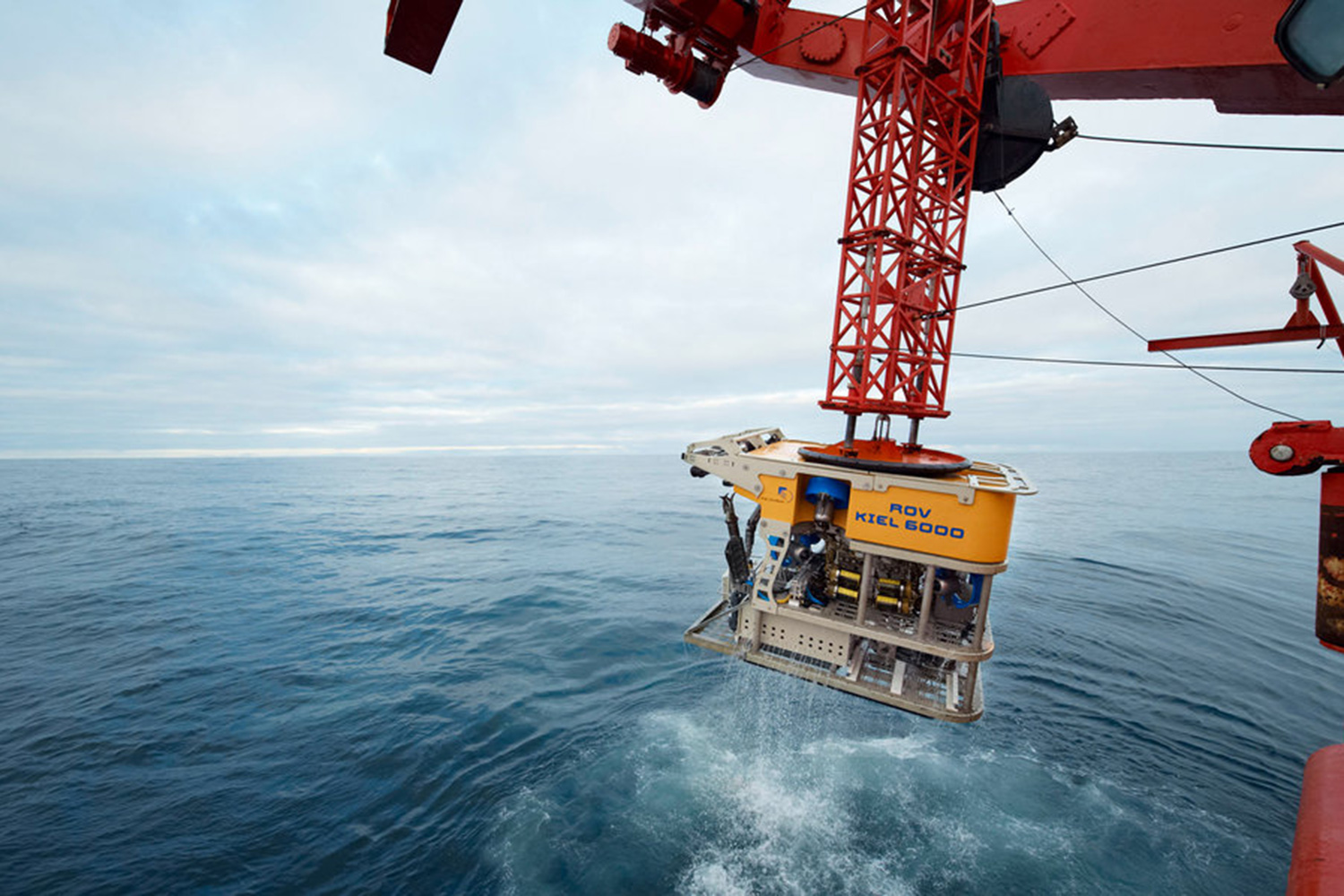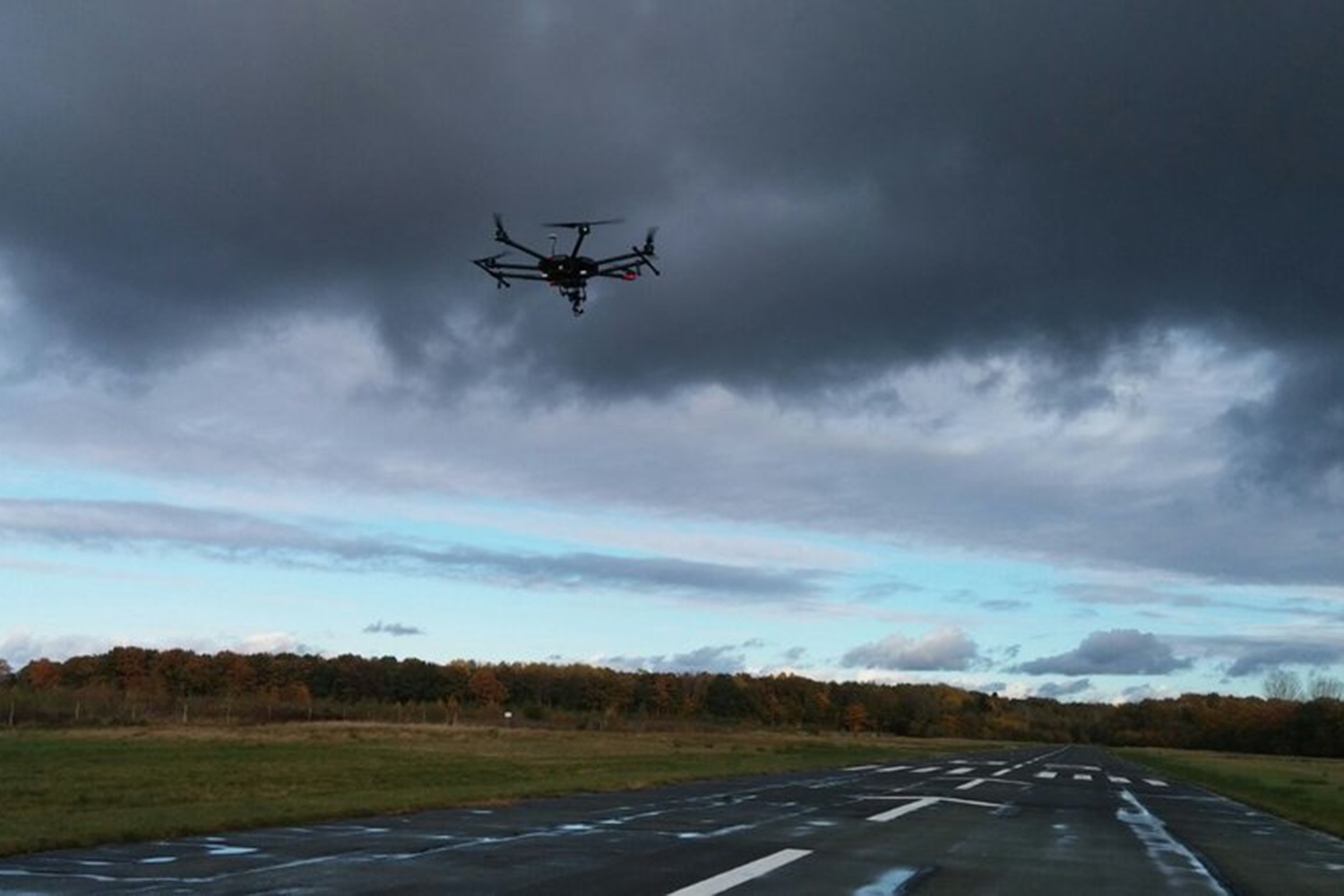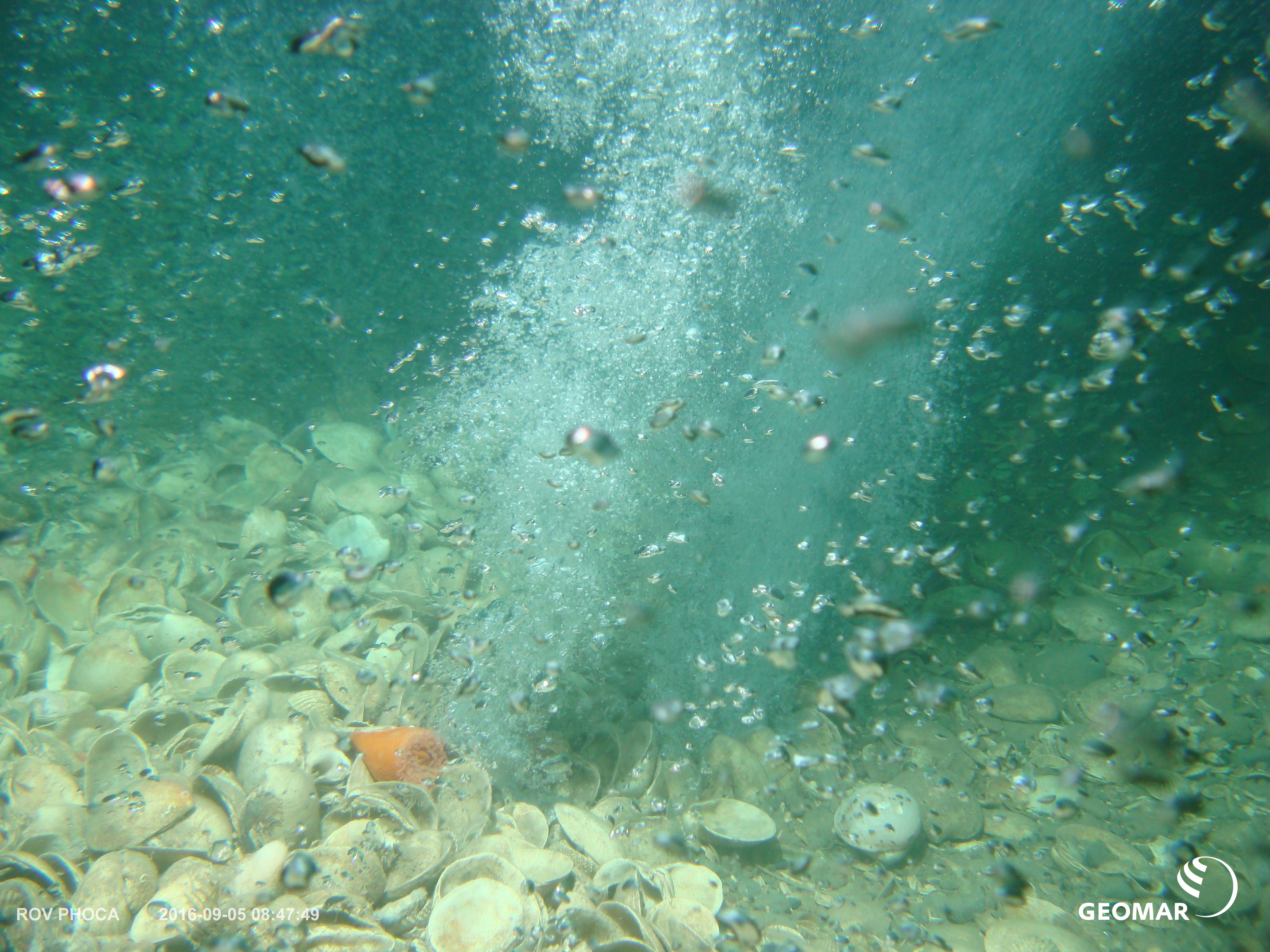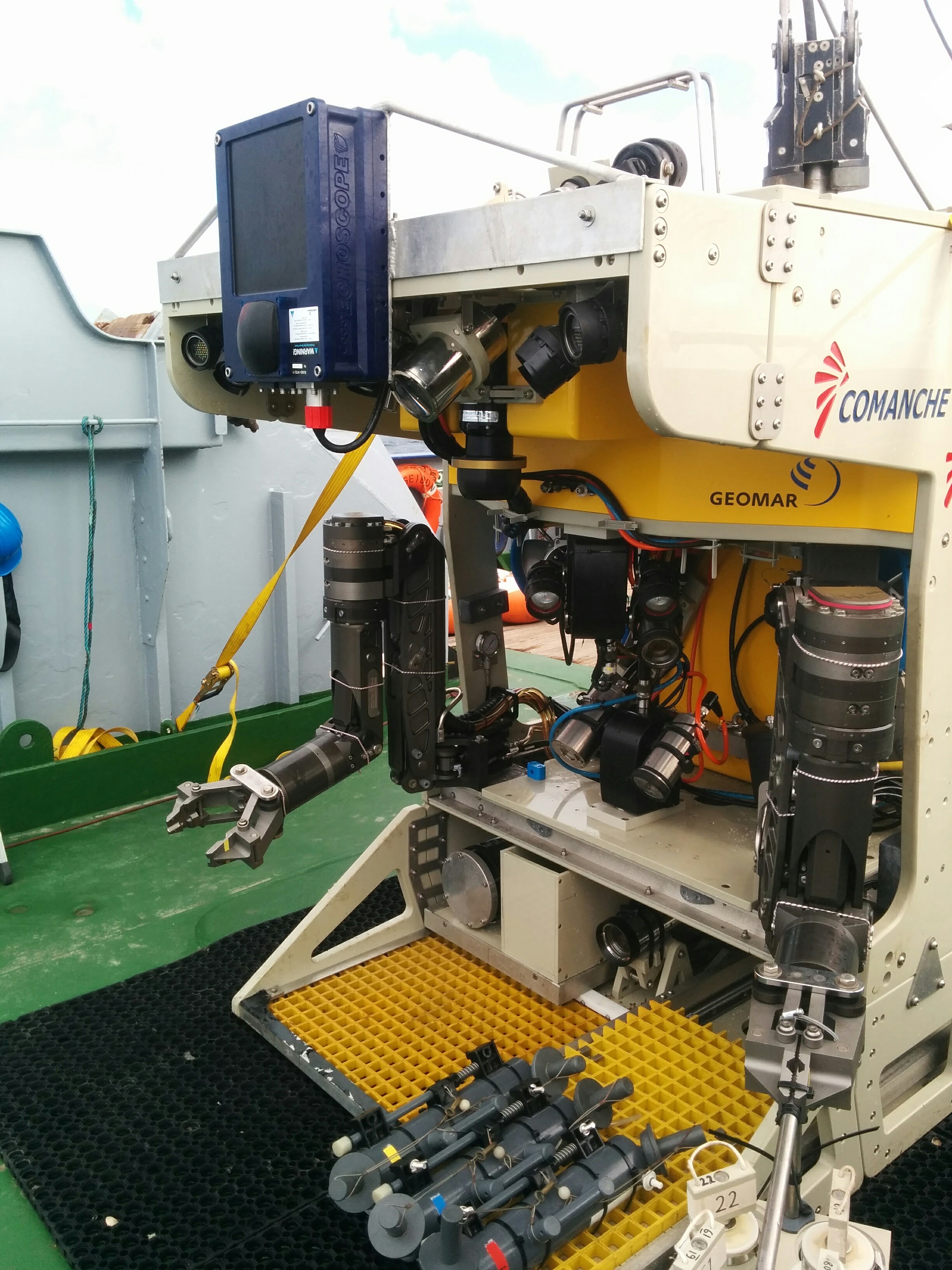Two potential causes for this are now beening investigated on a two-week expedition of the Kiel research ship Poseidon under the leadership of Kiel University (CAU) and in cooperation with the Leibniz Institute for Baltic Sea Research Warnemünde (IOW).
Scientists are studying whether the special form of the spiral vortex, in which the gas rises upwards in the water column, could be responsible for this „softening“. A further hypothesis is that methane-degrading microorganisms enter the water column with the ascending gas bubbles, transforming the climate gas into less harmful substances.
In 1990, an uncontrolled blowout took place in the English sector of the central North Sea after test drillings commissioned by the company Mobil North Sea (today ExxonMobil). The initially extreme storm of methane gas quickly dissapated, but up until today researchers have not been able to find the reason for this: Up to now this spot has been one of the most active marine methane gas sources world-wide. Scientists from the GEOMAR Helmholtz Centre for Ocean Research Kiel were able to verify continuing leaks of the climate gas methane in the 50 meter wide and 20 meter deep crater from the sea floor to the ocean’s surface during a research expedition with the research ship ALKOR in 2005. Thanks to numerous subsequent expeditions, the researchers were however also able to prove that during this process only small amounts of methane are transported from the source into the atmosphere.
Under the leadership of Dr. Jens Schneider von Deimling, geophysicist at the Institute for Geosciences at Kiel University, the research team of Kiel University and the Lebniz Institute for Baltic Sea Research together with colleagues from the University of California (UCLA) and the GEOMAR have now studied the crater in 95 meter water depth with a mix of hydro-acoustical, bio-chemical, micro-biological and oceanographic methods. The focus was on complex gas vortices and layers under the summer thermocline in the North Sea. Previous studies have provided clear evidence of the formation of gas bubble spiral vortices in the water column. Video recordings with the GEOMAR ROV PHOCA and ship-based multibeam echosounder studies on the so-called “spiral vortex” in the water column influenced by gas bubbles have shown that individual gas bubble currents released from the sediment combine into a spiral vortex.
During the current expedition, special sonars were used to prove the existence of such a spiral movement and to record it in a quantitative manner. The vortices are found in the temperature thermocline at a water depth of about 50 meters where methane concentrated water can be found. The researchers assume that they essentially influence the solution behavior and the distribution of methane in the water .
“Apparently gas bubble-induced swirls essentially contribute to a clearly stronger dissolving of the methane bubbles in the water than we thought in earlier models”, says expedition leader Dr. Jens Schneider von Deimling from the Institute of Geosciences at Kiel University and member of the Cluster of Excellence “The Future Ocean”. With the help of special acoustical procedures, the researchers hope to gain new insights into exactly how the spiral movement of the gas leaks influences the transport of the climate-damaging methane.
Another focus of the expedition was the question to what degree rising gas bubbles serve as a transport vehicle for bacteria which subsequently transform the dissolved methane in the water column into less damaging substances. The so-called methanotropic microorganisms can be found both in the sediment as well as in the water column of methane-rich areas. ”By using our bubble catcher at a weaker natural methane source off the coast of California, we were able to show that methane-degrading bacteria use this means of transport. Now we wanted to study how these results can be transferred to strong gas leaks, so-called mega seeps. The locally restricted leakage of gas bubbles also makes it possible to assess in a better manner how large the share of the bacteria rising with the bubbles is within the overall pool of the methane-consuming microorganisms in the water column surrounding the crater”, says Dr. Oliver Schmale, scientist at the Leibniz Institute for Baltic Sea Research Warnemünde and leader of the DFG project “Bubble shuttle – transport of methane-oxidizing microorganisms from the sediment into the water column through gas bubbles“.
Oliver Schmale was responsible for the studies on the microbial gas bubble transport on board the Poseidon. The cylinder of the bubble catcher filled with artificial, sterile sea water catches the gas bubbles rising from the floor together with the attached bacteria practically free of contamination so that a designation through subsequent microscopical analyses (CARD-FISH) is possible.
On the Poseidon a new, handy bubble catcher is being used which can also be operated by a ROV (Remote Operating Vehicle). “The use of such a remote-controlled underwater tool which also operates a highly specialized sampling and measurement device such as our bubble catcher is always nerve-racking. Too much can go wrong which could ruin the work of several months. But thanks to good preparation and smooth cooperation between ROV team of GEOMAR, the ship’s crew and us, the expedition was a great success.” For Oliver Schmale and IOW PhD candidate Sebastian Jordan the riskiest part of the project work has been successfully concluded: the samples have been taken. Now, laboratory work will start in Warnemünde and Kiel.
“The exact results of the expedition, when and to whiat degree spiral vortices form, will not be determined for a few months. Until then, more than three terabytes of data have to be processed in Kiel alone”, resumes expedition leader Dr. Jens Schneider von Deimling.
Links
www.futureocean.org
www.io-warnemuende.de
Publications on the topic
Schneider von Deimling, J., P. Linke, M. Schmidt and G. Rehder (2015). Ongoing methane discharge at well site 22/4b (North Sea) and discovery of a spiral vortex bubble plume motion. Marine and Petroleum Geology, Vol 68, Part B: 718-730
doi: 10.1016/j.marpetgeo.2015.07.026 (open access)
Schmale O., Leifer I., Schneider v. Deimling J., Stolle C., Krause S., Kießlich K., Frahm A., and Treude T. (2015). Bubble Transport Mechanism: Indications for a gas bubble-mediated inoculation of benthic methanotrophs into the water column, Cont. Shelf Res., 103, 70-78.
www.geomar.de/de/entdecken/artikel/article/eine-quelle-neuer-einsichten-in-die-risiken-der-marinen-gas-und-oelfoerderung
Contact
Dr. Jens Schneider von Deimling, Institute for Geosciences, Kiel University, Telephone (0431) 880-5792
jschneider@geophysik.uni-kiel.de
Dr. Oliver Schmale, Leibniz Institute for Baltic Sea Research Warnemünde (IOW), Section Marin Chemistry, Telephone (0381) 5197-305
oliver.schmale@io-warnemuende.de
Friederike Balzereit, Public Relations, Cluster of Excellence “The Future Ocean”, Telephone (0431) 880-3032
fbalzereit@uv.uni-kiel.de
…
Press material
Researcher from Kiel and Warnemünde study methane gas sources in the northern North Sea. Photograph from the ROV PHOCA of the GEOMAR.
Photo: ROV PHOCA Team / GEOMAR Kiel
A Bubble Catcher developed at the IOW collects the rising methane gas bubbles for further microbiological analyses. The placing of the instrument on the floor and the sampling of the gas bubbles is done by the ROV PHOCA.
Photo: Oliver Schmale, IOW

